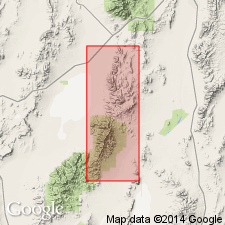
- Usage in publication:
-
- Swett tuff member
- Modifications:
-
- Areal extent
- AAPG geologic province:
-
- Great Basin province
Summary:
Pg. 138 (fig. 3). Swett tuff member of Quichapa formation. Geographically extended into eastern Nevada. [Age is Oligocene.]
Source: US geologic names lexicon (USGS Bull. 1200, p. 3792).
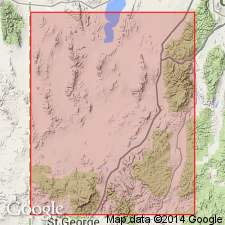
- Usage in publication:
-
- Swett tuff member
- Modifications:
-
- Original reference
- Dominant lithology:
-
- Tuff
- AAPG geologic province:
-
- Great Basin province
Summary:
Pg. 90 (table 1), 92 (fig. 2), 94. Swett tuff member of Quichapa formation. At type locality, underlies Bauers tuff member and overlies Leach Canyon tuff member (both new); elsewhere lava flows or other volcanic rocks, local in extent and origin, present at contacts. Thickness 30 to 45 feet in Swett Hills. An ignimbrite similar to Bauers tuff. Zircon age of Leach Canyon tuff member is 28 million years; this suggests that Quichapa formation is Oligocene. Report is discussion of ignimbrites of area.
Type locality: west-facing scarp of Swett Hills, Desert Mound quadrangle, Iron Springs district, Iron Co., southwestern UT.
Source: US geologic names lexicon (USGS Bull. 1200, p. 3792).
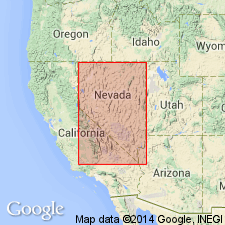
- Usage in publication:
-
- Swett Ignimbrite Member
- Modifications:
-
- Revised
- AAPG geologic province:
-
- Great Basin province
Summary:
Swett Ignimbrite, basal member of Condor Canyon Formation. Reassigned from Quichapa Formation. Overlies Leach Canyon Tuff. Underlies Bauers Ignimbrite, upper member of Condor Canyon. Thickness 30 to 450 feet. Age is Oligocene.
In Condor Canyon, Lincoln County, eastern Nevada, divisable into three zones: (1) a lower black-glass zone about 25 feet thick; (2) a middle lithoidal zone streaked with parallel gray lenticles about 125 feet thick; and (3) an upper structureless pale purple lithoidal zone about 15 feet thick. Total thickness 164 feet.
Source: Modified from GNU records (USGS DDS-6; Denver GNULEX).
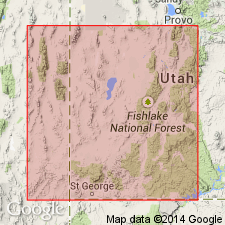
- Usage in publication:
-
- Swett Tuff Member*
- Modifications:
-
- Adopted
- Age modified
- AAPG geologic province:
-
- Great Basin province
Summary:
Pg. B10-B11 (fig. 2), B13; see also Anderson and Rowley, 1975, GSA Spec. Paper 160, p. 1-51. Swett Tuff Member of Condor Canyon Formation of Quichapa Group is adopted by the USGS. Swett Tuff Member of Mackin (1960) adopted as lower of two members of Condor Canyon Formation of Quichapa Group (now raised in rank) [following Williams, 1967, Univ. Washington PhD dissert.; Cook, 1965, Nevada Bur. Mines Rpt., no. 11]. Is a medium brown, densely welded, crystal-poor, ash-flow tuff compound cooling unit. Thickness less than 16 m. Overlies Bear Valley Formation (not part of Quichapa); underlies Bauers Tuff Member of Condor Canyon. Recognized in Utah and Nevada; notable exposures in southwestern Black Mountains. Numerous K-Ar age determinations (Armstrong, 1970, Geochemica et Cosmochimica Acta, v. 34) indicate age is about 23 Ma, early Miocene.
Source: Publication; Changes in stratigraphic nomenclature, 1976 (USGS Bull. 1435-A, p. A101-A102).
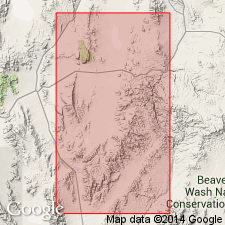
- Usage in publication:
-
- Swett Tuff Member*
- Modifications:
-
- Geochronologic dating
- Areal extent
- AAPG geologic province:
-
- Great Basin province
Summary:
Pg. A19 (table 1), A25; and Rowley and others, Chap. B of this vol., p. B52 (fig. 4), B56; see also preliminary results of geochemical studies by Nealey and others, Chap. C of this vol. Swett Tuff Member of Condor Canyon Formation of Quichapa Group. A densely welded biotite rhyolite ash-flow tuff [IUGS classification of Le Maitre, 1989]. Source is Caliente caldera complex. Age is considered earliest Miocene. Average of six K-Ar dates is 23.7 Ma (Armstrong, 1970, Geochemica et Cosmochimica Acta, v. 34; recalculated to new constants), but its true age is probably closer to the age of the Bauers (22.8 Ma, based on average of two Ar40/Ar39 dates by A.L. Deino, as reported in Best and others, 1989, New Mexico Bur. Mines Min. Res. Mem., no. 47, p. 91-133).
Source: Publication.
For more information, please contact Nancy Stamm, Geologic Names Committee Secretary.
Asterisk (*) indicates published by U.S. Geological Survey authors.
"No current usage" (†) implies that a name has been abandoned or has fallen into disuse. Former usage and, if known, replacement name given in parentheses ( ).
Slash (/) indicates name conflicts with nomenclatural guidelines (CSN, 1933; ACSN, 1961, 1970; NACSN, 1983, 2005, 2021). May be explained within brackets ([ ]).

